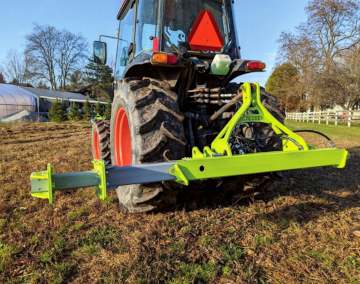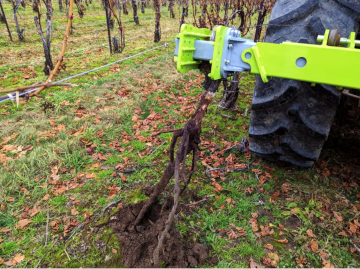
Ontario-based Thiessen Tillage’s tractor-mounted tool reduces the costs of vineyard upkeep
By Thomas Renner
Fluid Power General Machine BuildingHydraulic vine puller features steel telescopic cylinders and triboplastics to eliminate need for lubrication.

Designed and developed by St. Catharines-based Thiessen Tillage, this tool simplifies the common task of up-rooting vines that have died due to damage, disease or a cold winter.
(Photo credit: Thiessen Tillage)
All across Canada, farmers are facing higher costs for doing business. Costs on Quebec farms rose by an average of 17.3 percent in 2022, according to a report. Every aspect of the industry – land, fertilizer, machinery, livestock and feed – saw double digit increases. Even something as simple as twine – which is used for wrapping hay bales – increased by more than 15 percent.
Like all Canadians, farmers are paying much more for fuel. Farmers paid more than 78 percent more for fuel in the second quarter of 2022 than the previous year and consumers are feeling the cost. Grocery prices rose 9.0 percent year over year, according to a report in May.
A new cultivation product – developed by St. Catharines, ON-based Thiessen Tillage – aims to help farmers curb some costs. Designed by Thiessen’s owner and operator, Ryan Thiessen, the product is a hydraulically-actuated toolbar that mounts on either the front or rear of a tractor to pull vines or small trees out of vineyards and orchards.
A Better Option
Intermittent vine pulling is common in vineyards due to damage or disease. And, in more northern climates, like southern Ontario, individual vines may not survive a cold winter. As a result, farmers often need to pull individual vines so they can be replaced with new ones.
In most instances, farmers have used skid steer loaders for this task. However, skid steers are far more expensive – as in mid five figures expensive – and require some lateral movement instead of direct pulling of the vine, which slows down the process.
While skid steers might be faster than the 3-point hitch for removing many vines, Thiessen says not every farmer will have the resources to have a skid steer. Tractors, on the other hand, are a must-have for any farmer.
“For farmers without skid steers and who pull dead vines annually, having a tool like our vine puller is a better option than always hiring the job out and is still fairly quick,” Thiessen says.
Customers have embraced the product, Thiessen says, and enjoy having a solution for a frequent problem that can be used on standard equipment.
“They’ve been very happy with the vine puller and the ease of use on standard tractors,” he said. “It’s something a lot of farmers encounter, and this is a solution that doesn’t require additional equipment and greatly reduces the use of grease.”
Nesting Cylinders
Thiessen designed the toolbar with nesting cylinders inside telescopic tubing with narrow profile pins. The liner allows the telescoping elements of the vine puller, which are made with steel, to slide against each other while reducing wear and friction.
“We solved that challenge by nesting the cylinders inside of the telescopic tubing with narrow profile pins to secure them so that we didn’t need to make room externally for the cylinders and other related components,” he said.
The liner is the critical component to the vine puller. The telescoping elements are steel, which can cause significant friction. Lubrication, however, is messy and over time can be expensive. Thiessen’s solution, however, doesn’t require lubrication. Instead, the vine puller uses self-lubricating plastic components from igus. Thiessen says the German company’s motion plastics stand up better to the corrosiveness associated with agriculture while also eliminating the cost and maintenance of grease lubrication.

Thiessen’s hydraulically actuated vine removal tool can be mounted in and integrated with common farm tractors, eliminating the need for expensive specialty equipment.
(Photo credit: Thiessen Tillage)
“I am on a mission to reduce or eliminate grease and grease fittings from agriculture,” Thiessen says. “While grease is an excellent lubricant, farming involves a lot of dust and soil. These contaminants quickly become embedded in the grease and create a messy and less effective slurry.”
He initially developed the toolbar with igus’ B160 tribo-tape and cut it to fit on the cylinders. “The tribo-tape is easy to apply and cut to size which made it easy to integrate and install into the assembly,” Thiessen says.
The tribo-tape liner is designed for versatile lining of tribologically challenged services and shapes and optimizes movement within machine beds. It requires very little space – it has a thickness of .5mm – and can be purchased with an adhesive back.
Over time, however, Thiessen discovered a different igus product that stood up better to the challenging demands of the application. He now uses an iglide J plate, which offers low wear against different shaft materials, good resistance to chemicals and low coefficients of friction in dry operation.
The plate is used frequently in plant construction, maintenance equipment, machine construction and medical technology.
“The tribo-tape was awesome and a solid product, but in the end the forces we were experiencing with the vine puller and other heavy vineyard tools was wearing the much softer tribo-tape too quickly. Also, the adhesive had trouble with too much hydraulic oil if a farmer had a leak,” Thiessen says. “It is still a very capable product, but in our case mechanically fastened parts we cut from J plate has been a better solution.”
Additional Savings
Like everything else associated with farming, the cost of grease is on the rise. A report in February 2023 said Lubrication Engineers increased the price of its lithium complex greases approximately 27 percent, and Chevron said it would raise the price of its greases by 17 percent. Another report in October indicated prices would rise 12-18 percent for lubricants and greases.
Grease has been used on equipment dating back centuries. But there are different grades of grease and using inferior grades can lead to equipment degradation. The cost of lubrication is tied closely to the cost of fuel, and most theories suggest owners can add 10-15 percent to the cost of fuel for lubrication. Fuel prices have also risen dramatically over the past three years.
“By moving away from grease and towards more of the high-tech plastics from igus we are able to reduce maintenance time and costs,” Thiessen said. “We no longer have to grease equipment and makes it easy to clean because the grease no longer holds contaminants and sticks to the steel. It makes a better, cleaner looking product.”
www.thiessentillage.com
Thomas Renner writes on engineering, construction and other industry topics for publications throughout the U.S. and Canada.
